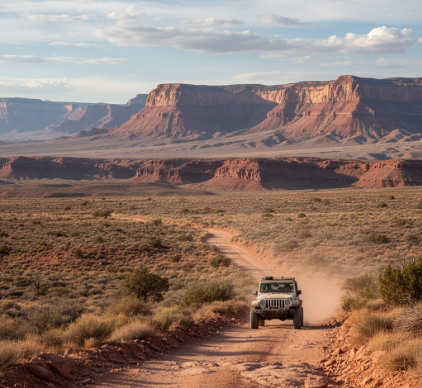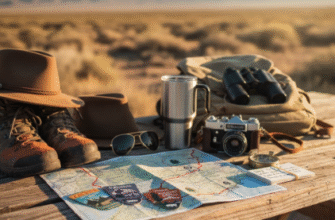The Arizona Strip doesn’t care if you find it.
I’ve driven through a lot of remote places—Mojave backcountry, Nevada’s Basin and Range, even parts of the Sonoran that feel like Mars—but the Strip has this quality of deliberate inaccessibility that’s hard to shake. It’s that wedge of Arizona north of the Grand Canyon, south of Utah, cut off from the rest of the state by one of the planet’s most dramatic geological scars. Getting there requires commitment: you’re looking at roughly 240 miles from Las Vegas, maybe 120 from St. George if you’re lucky, and the last stretch? Dirt roads that turn to soup when it rains, which happens more than you’d think for a place this arid. The Grand Canyon-Parashant National Monument sprawls across 1.05 million acres here, co-managed by the Bureau of Land Management and the National Park Service since 2000, and here’s the thing—almost nobody goes. Visitation hovers around 15,000 annually, compared to six million at the main Grand Canyon. You do the math.
Why the Road Itself Becomes the Destination When You’re This Far From Anywhere
Honestly, I used to think the appeal of wilderness drives was about what you see at the end. Turns out, the Arizona Strip flips that logic. The roads—Mount Trumbull Loop, Mainstreet Valley, the rutted track to Whitmore Canyon—they’re not really routes to a place. They’re the experience. High-clearance 4WD isn’t a suggestion; it’s survival. I’ve seen rental SUVs abandoned near Poverty Flat, and I get it, the volcanic rock fields shred tires like they’re personally offended by rubber. The landscape oscillates between juniper-dotted plateaus at 5,000 feet and stark desert basins, then突然—wait, suddenly—you’re staring into side canyons that drop 2,000 vertical feet into geological time. The Toroweap Formation here dates back roughly 270 million years, give or take, Permian-era limestone that holds fossils of ancient seas.
What Actually Lives Out Here Besides Your Growing Sense of Insignificance
The ecology is weirder than it should be. Desert bighorn sheep navigate cliffs that make my palms sweat from a quarter-mile away. California condors—those Pleistocene relics with 9.5-foot wingspans—soar over the Vermilion Cliffs, part of a reintroduction program that’s been running since 1996. There are maybe 500 total in the wild now, and a decent chunk patrol this exact airspace. Pronghorn antelope, which aren’t actually antelope but the last survivors of a family that included animals with four horns, cross the grasslands at speeds up to 55 mph, which seems excessive until you remember they evolved running from American cheetahs that went extinct 12,000 years ago. And the plants—Utah agave blooms once after 15-25 years, then dies; blackbrush dominates the lower elevations in dense, scratchy carpets that haven’t changed much since the last ice age.
The Parashant Wilderness Doesn’t Perform For You It Just Exists Stubbornly
No services. No cell reception, obviously. The nearest gas is back in Fredonia or Colorado City, both tiny, both requiring planning. I guess it makes sense that Congress designated 87% of the monument as wilderness in 2009, because infrastructure here would be absurd anyway. The names tell you everything: Lone Mountain, Lost Spring, Suicide Canyon. Mount Dellenbaugh rises to 7,072 feet, named for a teenage artist on John Wesley Powell’s second expedition in 1871—Powell, who first mapped the Colorado River through the Grand Canyon, called this region “altogether valueless,” which feels harsh but also maybe accurate depending on what you value. There are lava flows from volcanic fields that erupted as recently as 10,000 years ago, geologically yesterday. The silence is physical, the kind that makes your ears ring, and when wind picks up it carries dust that gets into everything—cameras, water bottles, teeth.
Why Anyone Would Deliberately Choose Discomfort Over the Paved Alternative Routes
I used to not understand this. The North Rim is right there, accessable via Highway 67, with lodges and rangers and guardrails. But the Strip requires you to recieve it on its terms, and maybe that’s the entire point. You can’t scroll through it. There’s no gift shop version. The Tuweep (or Toroweap—spellings vary, which is very on-brand) Overlook offers a 3,000-foot vertical drop view into the Grand Canyon with zero barriers, just you and geology and the creeping realization that one stumble ends badly. It’s not Instagram-friendly so much as it’s terrifying and sublime in equal measure. Nights here hit freezing even in May; summer days crack 105°F. Water sources are scarce and often unreliable—always carry extra, always tell someone your route, always check weather because flash floods reshape roads without asking permission. The BLM estimates it takes 4-6 hours just to cross the monument depending on conditions, and that’s if nothing goes wrong, which is definately not guaranteed. But maybe that’s why it works. The effort filters for intent. You don’t end up here by accident.









